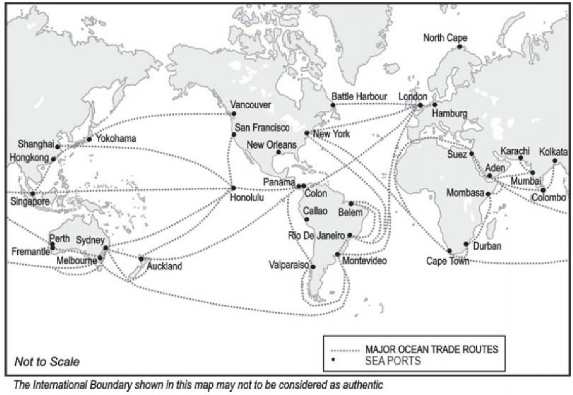1.2.2.1. Main Ocean Routes of the World

North Atlantic Ocean Route: It is one of the busiest sea routes in the world. It is also known as Big Trunk Route. Approx 25 per cent of the ships of the world ply on this route. The main ports of Western Europe are Glasgow and London (U.K.), Rotterdam (Netherlands), Antwerp (Belgium), I.e. Havre and Bordeaux (France). Main ports of North America are: Quebec and Montreal (Canada); Boston, New York and Baltimore (U.S.A.). Goods shipped from Europe to Canada and the U.S.A includes manufactured goods like clothes, chemicals, fertilisers, wines etc. From Canada and the U.S.A to Europe, items include food grains, iron and steel, transport equipment etc.
Mediterranean-Red Sea-Indian Ocean Route: This route connects Eastern Africa, Southern Asia and countries of Far East to West European countries. This is a very important ocean route of the world. It passes through North Sea, Atlantic Ocean Mediterranean Sea, Red Sea, Arabian Sea, Indian Ocean and South China Sea. The Suez Canal route has reduced the distance 6,400 km. Main Ports include Port Said, Aden, Karachi, Mumbai, Kochi, Colombo, Singapore and Bangkok. Materials moving towards East constitute mainly machines and industrial products etc. while materials moving towards West are raw materials, cotton, tea, coffee, sugar, rubber, petroleum, etc.
Cape Ocean Route (Cape of Good Hope Route): Before the opening of Suez Canal Route, Europeans used to pass through this route while visiting India, China and Australia. Still, this route connects Western Africa, South Africa, Australia and New Zealand to Western Europe for trade, these days. Main Ports in this route are London, Lisbon, Cape Town, Adelaide, Melbourne, Sydney, Wellington (New Zealand). Palm-oil, wood, almond and copper are sent to Europe from Africa while wheat, maize, wool, etc. are sent to Africa from Australia. Industrial products are sent from Europe to Africa and Australia.
South Atlantic Route: The trade between the countries of South America and Europe is being carried out through this route. Brazil, Argentina, Uruguay are the main countries of South America benefitted by this route. This route is comparatively less important. Quantity of trade is less because of the underdeveloped West African countries. Main Ports on this route include London, Liverpool, Hamburg (Europe) Kingston, Havana (West Indies) Rio-de Janeiro (Brazil, Buenos Aires (Argentina), Montevideo (Uruguay). Materials transported include coffee, rubber, sugar, meat, wool, wheat, are sent from countries of South America and West Indies to Europe. Coal, machines and industrial products are sent from Europe to these countries.
North Pacific Ocean Route: This route is used for trade between western regions of North America and Japan; and China and Far East Asia. These ocean routes are lengthy route and lack facilities of harbours and refilling fuels. Main Ports include Yokohama, Tokyo, Shanghai and Manila in East Asia and San Francisco, Seattle and Los Angeles in Western North America. Goods Transported are silk and tea from Japan, wool and different minerals from Australia are sent through this route to North America. In return, North America sends wood, cereals, petroleum and finished goods to Australia, Japan and New Zealand.
Major Sea Routes round the world

1.2.2.2. Main Shipping Canals
Shipping canals are canals especially intended to accommodate ships used on the oceans, seas or lakes to which it is connected. As opposed to it, a barge canal is intended to carry barges and other vessels specifically designed for river and/or canal navigation. Because of the constraints of accommodating vessels capable of navigating large bodies of open water, a ship canal typically offers deeper water. Ship canals are constructed for a number of reasons which include creating a shortcut and avoiding lengthy detours; to create a navigable shipping link between two land-locked seas or lakes; to provide inland cities with a direct shipping link to the sea; and to provide an economical alternative to other options.
